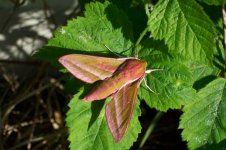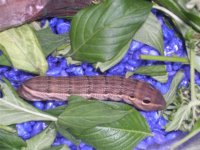T Foster said:
Harry,
I live in Katy, TX (just outside of Houston). I found a Elephant Hawlk Larva on a plant outside my door today. I did extensive searching on my computer to identify it. I am amazed because I have found only two people in the US referencing this type of larva. One in Hawaii and the other in Colorado (who received it as a gift from a friend in the UK). Is this common to see in our area? Also, I would love for my four children to see it become an adult. What do I need to do to help this happen?
We have placed it in a plastic insect container with several branches with leaves from the plant where we found it. Is that good enough?
You seem very knowledgable and my girls and I would appreciate any insite you can give us. Thanks!
Hello T. Foster,
Welcome to the entomological section of Bird Forum.
The Elephant Hawkmoth does occur in the USA, but I do not have any data as to its range in your country. It is a very widespread species in Britain and over nearly all Europe south of the Arctic Circle to the Mediterranean Sea.
Worldwide there are some 1,100 Hawkmoth (Sphingid) species so I hope you have identified your larva correctly. If you could post a picture of it here, it would help us to verify the identification.
Has the larva eaten any of the foodplant you have given it? If so, it looks like that may not be a problem. Elephant Hawkmoth larva will eat a variety of different plants.
Rearing them isn't a difficult thing to do, and your insect cage should be suitable. I would recommend however that you change the food plant twice a day.
With this species it is important not to put the cut lengths of foodplant in water as they tend to suffer and die if this is done. Cleanliness is important and the cage should be cleaned out every time you change the food.
Try to avoid handling the larva if possible, they have to moult several times during the larval period and handling them during the moulting process may kill them. Wherever possible lift the stem of the foodplant on which the larva is resting out of cage, then remove all the old foodplant and droppings, replenish the food supply, and then replace the stem on which the larva is resting back into the cage.
Elephant Hawk larva pupate on the surface of the ground in a loose cocoon of dead leaves spun together. To prepare for this and to ensure that the larva and pupa have a good chance of survival, I take a couple of handfull of fresh leaves, put them on a baking tray and dry them off in an oven set at 100 degrees C for 20-30 minutes. This will effectively sterilise the leaves and at the same time remove the moisture present thus helping to prevent mould occurring.
When the larva is ready to pupate it will take on an
oily appearance, when this happens, remove the larva from the cage, remove all the foodplant and clean out any droppings etc. Place the dried leaves into the cage and replace the larva. It may wander around for several hours before burrowing into the leaves and starting to spin a cocoon. Once this happens leave the cage alone for at least three weeks. This will enable the larva to complete the cocoon, pupate and give time for the pupa to harden. After three weeks it is then possible to remove the dried leaves one at a time until you have only the cocoon containing the pupa left.
Keep the growing larva and the pupa in a shaded and cool place, neither appreciate direct sunlight, an unheated garage or cellar is ideal.
It may well be that in the warm climate of Texas, that this species is double or even continuously brooded, Check the cage every day in the evening, and sooner or later you (hopefully) will be rewarded with an adult specimen. See attached photograph.
Rearing insect is a very rewarding experience, I hope you and your children are successful.
Please don't hesitate to ask further questions if you run into problems.
Regards,
Harry.





